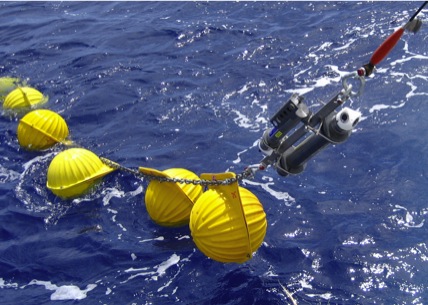Chapter 16 of Descriptive Physical Oceanography by Talley (2011) focuses on methods and instrumentation for measuring the large-scale circulation and water properties of the ocean. Chereskin and Howe (2007) provide a compendium of in situ and satellite instrumentation and their uses in modern research oceanography (see link below). The instrumentation and experimentation they describe are for dynamical measurements of the ocean, including temperature, salinity, and pressure for density. Following is a brief list of some of the more common instrumentation in physical oceanography.
CTD - “Conductivity Temperature Depth” - measures salinity (S), temperature (T), and pressure (P). The true workhorse of physical oceanography. Usually combined with sampling bottle rosette, as seen in the photo to the right.



ADCP - “Acoustic Doppler Current Profiler” - measures velocity. Can be deployed on a mooring, on a CTD package, or mounted in the hull of a ship. All US research vessels have hull-mounted ADCPs.
Argo float - floats with the currents at a fixed pressure (typically 1000 m) for a number of days (typically 10 days), then dips to 2000 m before rising to the surface, collecting a T,S,P profile. Once at the surface, floats transmit data to Argos system of satellites, before sinking again to repeat their mission. The Argo observation system consists of over 3000 floats worldwide.
CPIES - “Current meter and Pressure sensor equipped Inverted Echo Sounder” - measures velocity, pressure, and acoustic travel time. Moored on the bottom of the ocean. Typically used to estimate dynamic height and oceanic heat content.
Talley, L. D. (2011). Descriptive physical oceanography: an introduction. Academic press. https://doi.org/10.1016/B978-0-7506-4552-2.10028-9 Chereskin, T, and B. Howe (2007) Oceanographic Measurements. In Springer Handbook of Experimental Fluid Mechanics. Eds., Tropea, C., A. L. Yarin and J. F. Foss. Springer, Berlin, 1179-1217.
(1) Pop-up project proposal/outline
Chose an ocean current / circulation / system and be prepared to talk about it for three minutes--using Earth.nullschool as your visual aid--covering:
(a) The name of the current or system, its geography and mean circulation.
(b) Two significant facts/findings about the system, gleaned from a quick scan of two peer-reviewed research papers.
(c) Why you chose this system and what you hope to learn about it.
(2) Project paper and presentation
Write a cogent 4-page paper (with figures, plus extra length for citations) on your ocean current system, based on your reading of 5-10 peer-reviewed research papers. Include answers to the following questions:
(a) What methods have oceanographers used to better understand the system?
(b) How and why does the system vary in time and space? Give one example in detail.
(c) How is this system connected with other parts of the ocean? With the atmosphere? With the biosphere? With the cryosphere? Give one example in detail.
Configure your paper into a 10-minute talk (10 slides maximum) to be presented in class.






